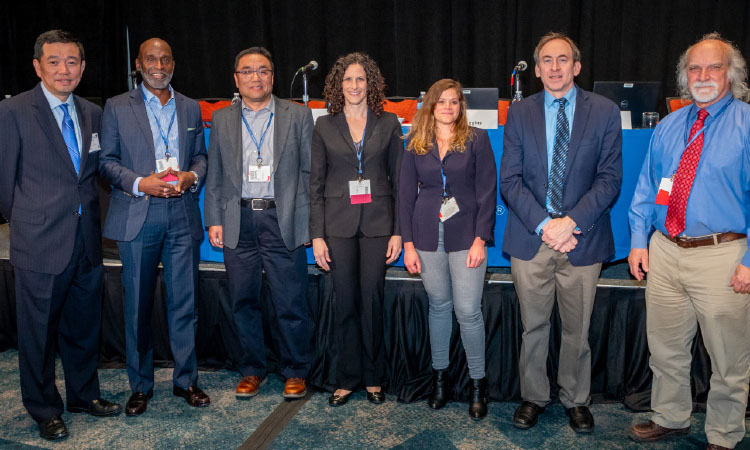- Log in or register to post comments
Regulatory Panel Session: Explores Key Aseptic Topics

The 2020 ISPE Aseptic Conference was capped off on Tuesday, 3 March, by the Interactive Regulatory Panel session, which has been a popular feature of the conference during its 29 years. The session featured a panel of seven US FDA regulators who addressed a long and varied list of questions about aseptic processing issues, including isolator environments, glove integrity tests, artificial intelligence (AI) and deep learning effects on automated visual inspection, container closure systems, settle plates, and more.
Robert Sausville moderated the session and participated in the discussions.
Other panel members were:

Sausville reminded attendees that the panel members’ responses were their opinions, not the position of the FDA. Of 47 questions submitted to the panel for the session, 36 were addressed by the panelists. The following are highlights from the questions and answers.
Do you accept isolator surrounding environment to be below Grade C (CNC, Grade D equivalent) for process isolators such as for cell therapy?
Higgins referred the questioner to the FDA “Guidance for Industry: Sterile Drug Products Produced by Aseptic Processing—Current Good Manufacturing Practice.”1 One of the principles in the guidance is that the classification of the room surrounding the isolator should be based on the design of the isolator and the kind of material transfer ports or systems used. Class 100,000 in operation (dynamic) is a commonly used classification and the minimum expectation, she added.
Can FDA please reconfirm its position on PUPSIT [preuse, poststerilization integrity testing of filters] as compared to that put forward in the commenting of Annex 1 in 2018?
Friedman said that the PUPSIT position in the FDA aseptic guidance is not in disharmony with Annex 1.2 The FDA guidance states that PUPSIT of filters can be done prior to processing, but a postuse integrity test should always be done. The draft Annex 1 (current version) indicates that pre- and postuse testing should be done, but, based on risk assessment and practical considerations, the manufacturer may be able to justify only postuse testing. “Guidance documents can be equivalent, but they will not necessarily be identical,” Friedman said. Expectations are that the FDA’s guidance and the Annex 1 currently out for comment will remain in harmony.
How does FDA control accuracy of glove integrity testing? Which hole size should be tested?
The FDA expects a robust testing device to be used, Friedman said. A specific hole size is not necessarily prescribed, but the device needs to be sufficiently sensitive (50 or more microns is used by some vendors; efforts should be made to use a lower sensitivity, if possible). Automated integrity tests are better than the human eye and more reproduceable, he said. “It is important to have a robust glove integrity testing device that will reliably detect holes in gloves, as nonintegral gloves can pose a critical risk to product sterility.”
Qiu added that it is really important when using automated equipment that the equipment is qualified to detect leaks.
FDA will update the 1999 guidance on container closure systems. Will the updates provide guidance [on] container closure integrity testing and when it should be done in development and manufacturing?
Mr. He said the FDA began to develop new high-level guidance for container closure systems late last year, and work continues on this high-level guidance that will replace the current guidance, “Container Closure Systems for Packaging Human Drugs and Biologics: Chemistry, Manufacturing, and Controls Documentation.”3
Mr. He noted that subguidances will be addressed after this is completed, and the high-level guidance will provide recommendations regarding the data to be provided to support the container closure system, including data to demonstrate container closure integrity.
Harman added that the umbrella guidance will provide general information and will have limited information regarding container closure integrity testing for specific products, and that the purpose of the subguidances will be to supplement the high-level guidance, providing additional recommendations with regard to container closure systems for specific products that are out of the scope of the high-level guidance.

With the advancements in AI and deep learning on automated visual inspection, do you believe it is plausible that groups could use virtual libraries for teaching equipment or training inspectors?
Sausville responded that these developments could be used for training, but the FDA still expects operators to visually inspect real vials as part of the training before they are qualified to do it in-line with actual product.
Friedman noted, “As a general statement on AI, software is designed by humans. Different circumstances and combinations of variables are considered by software developers in simulating or predicting situations. This is a higher-level comment on AI, but there still is no substitute for the human element of quality management when it comes to knowing what software is doing, understanding algorithms, and what decisions can be made under conditions not predicted or practically simulated by modeling. AI will most definitely advance manufacturing in many respects. But for qualifying or vali-dating personnel practices, there generally will be nothing better than final evaluations of the operation in practice in the actual production environment—this will ultimately be the most direct study and measure of true capability.” With that said, Friedman continued, the FDA would like to see AI leveraged for training. “AI is very promising—and machine learning is, too—for atypical interventions, for example. But for qualification and quality management, you cannot cede the responsibility to software.”
Sausville added, “One of the most compelling things that came to my mind had to do more with small-scale [products] we are seeing at CBER and visual inspection of those. Not necessarily AI, but the optics used for AI could be used to enhance the human visual inspector to visualize what’s in that vial. Less eye fatigue could be a good way to enhance that.”
Qiu noted that a lot of unknowns can come up that the system is not used to seeing. “How are you able to teach the [AI] system how to catch the unknowns?”
Guidances do not have to be the same to be equivalent and in harmony.
What do you think about an opinion that settle plates are not meaningful for environment of UDAF [unidirectional airflow] and active air samplers are suitable for effective monitoring considering the recovery rate?
Sausville said that the FDA has allowed the use of settle plates for many years, and continues to do so. “Would active air samplers be more effective? Probably so. We would rather see those as long as they don’t impact the environment of the filling area, the aseptic area.” See the FDA aseptic processing guidance,1 section X.A.4, for more detailed information on the preferred use of active air monitoring devices and discussion of settle plates.
What do you think about employment of video recording in isolators for process control? There’s a company that utilizes video recording of glove operation, environmental monitoring, etc., for ris[k].
Higgins said, “Video recording is only going to help you. We want to encourage the use of it. We’ve seen it aid firms in investigations if something has gone wrong; it is easy to pull the video and see what operators were doing. Beyond the isolator, it is also helpful in sterility testing in isolators and in-vestigating cleaning issues.”
What are the expectations for lyo[philization] process validation in terms of at-scale lyo runs requirements? Can the boundary studies be performed at lab scale instead of manufacturing scale?
Harman said the expectation for process validation is ideally three runs at the maximum load and one run at the minimum load performed at target operating parameters (shelf-temperature, chamber pressure) and with extended sampling. Regarding boundary studies performed at small scale, these studies could be used to leverage the at-scale process validation, provided that there is a comprehensive understanding of the differences in the lyophilizers and the scale-up. The scale-up can be affected when considering different lyophilizers (lab scale vs. commercial scale); these changes include changes in the vial heat transfer coefficient as a result of the changes in the ratio of center to edge of vials on the shelf (geometry of the lyophilizer) and differences in the radiation of the walls of the lyophilizer (differences in the materials of construction and thermal history). Additionally, the design of the lyophilizer in relation to water flow capability and differences in process parameters should be considered. She indicated that the FDA is amenable to the use of leveraging boundary studies performed at small scale to support process validation, provided there is extensive supporting information (i.e., modeling that takes into account the effects of scale-up between lab-scale and commercial-scale lyos).
Annex 1 draft has been released. As part of PIC/S [Pharmaceutical Inspection Co-operation Scheme], how will FDA consider implementing this GMP document in the US?
Friedman said the FDA is on the work group at PIC/S that inputs into the EU’s Annex 1. “Through that venue, we have endeavored to maintain equivalency, and I think our group has been successful. As mentioned, guidances do not have to be the same to be equivalent and in harmony. The aseptic guidance covers topics that are not found in Annex 1, and vice versa. Annex 1 also addresses terminal sterilization. But they are complementary guidances. Regulators can provide more specificity on certain topics that they have found need further articulation of GMP expectations, but while there may be differences in depth of coverage of some topics, the two guidances work hand in hand. They are interchangeable. We’ll be on the committee through PIC/S for further input as Annex 1 ultimately moves to the finalization stage.”
Can you please share your experience with the Mutual Recognition Agreement (MRA) between the US and the EU up to now?
Cruse noted that the FDA signed the MRA with the EU in November 2017. Capability assessments were undertaken from then through July 2019 with 27 countries (originally 28 because the United Kingdom was part of the EU at that time), and the EU did a capability assessment of the FDA. Cruse said that since November 2017, the FDA has been requesting reports for sites from its risk-based selection model. “We are performing analytical review of the inspectional reports. We are using the reports from EU countries for decisions on things like on classifying an inspection or whether a site is cleared for application for marketing products.” Only surveillance inspections are included now, he said, but future uses under consideration are preapproval inspections and possibly vaccines and biologics at some point. Progress is good, he noted—the program is maturing and starting to take a deeper dive into more provisions. “I should add that as we are reviewing and classifying, [we are] also sending classification letters back to the companies that we deem acceptable” based on the inspection results of the local European authority.
What is the current regulatory expectation for 02 headspace monitoring? Is the expectation that 100% of vials are monitored? Is high stopper detection required/expected?
Most firms are monitoring headspace, but 100% monitoring is not generally a requirement, Mr. He noted.
However, stopper position should be checked during 100% visual inspections. Further, automated stopper height detection devices are also common.
Qiu added that in measuring for syringe stopper positions, it is also important to assess stopper position after shipping, especially if air shipping, because the stopper may move and could impact the sterile boundary.
Particle recovery in low concentrations makes recovery at >5 microns inappropriate. In Annex 1, this is recognized in classification but not in monitoring, hence no alignment with FDA guidance. Is this an issue?
“We were not seeing a lot of problems with 5 microns, so we were silent on the matter in the aseptic guidance,” Friedman said. “Industry in the EU believes that the original 5-micron particle value in Annex I was too stringent and triggered too many investigations, so ultimately the limit changed. I know that folks struggled with coming up with an exact number. At your company, 29 or 10 or 15 might be highly abnormal. Bottom line: the overarch-ing position is aligned between regulators—the HVAC system must provide for highly controlled environmental conditions that prevent contamination.” He added that significant levels of 5-micron particles would be abnormal and could signal that there is something to worry about.
What are requirements for use of surrogates in DP [drug product] fill-finish process? Specifically, if surrogate is used for lyo studies, mixing studies, etc., due to limited availability of drug substance (DS).
Sausville noted that for fill-finish processes, media simulations are nothing but surrogates.
For the second part of the question, Higgins noted that surrogate usage may be allowed during early development activities; however, “once there are PPQ [process performance qualification] batches, we expect actual drug product would be used.”
Qiu added, “In CDER, when we are observing the manufacturing process during an inspection, in general we prefer to have actual product. But if you have justification, and the surrogate has a similar manufacturing process, we will consider it to support an inspection. In supporting data as part of process validation for commercial, we expect actual product. Early on, you can use a surrogate. When you submit the application, you must submit validation data to support commercial manufacture of the product. I’m not sure how a surrogate could be used if it is not the product you intend to license.”
Can you give an update on the New Inspection Protocol Project (NIPP)? How are the protocols working? Will they result in different ways the agency reports inspection data?
The new protocol has been in use for about two years, only in sterile dosage forms, both domestically and internationally, Cruse said, although other dosage forms are being worked on. He added that he hopes there will be pilot testing of these later this year. The use of an intelligent questionnaire, a dynamic tool to help gather and structure data, is part of NIPP; however, Cruse emphasized, it does not replace the investigator's role in searching for and looking at critical information.
“Our inspections tend to look for deviations or things that are out of place. NIPP will allow FDA inspections to highlight areas that may exceed quality best practices or a new way of achieving higher levels of compliance.”
Through the entire process, including pilots and every time an inspection is done, the process seeks feedback from the investigator to make NIPP more useful. The number of questions has been reduced, and the FDA is looking at using the questionnaire in conjunction with a tablet.
“Where we are now, it is moving quite well, and we are looking forward to additional feedback from investigators,” Cruse said.
What is considered a robust validation strategy for validation of a process with the option of using 1 of 3 identical lyo units? Is one run per a lyo required?
Harman said the expectation is to perform three runs at the maximum loads, and one run at the minimum load in one lyophilizer, and one run at the maximum load in each additional lyophilizer, provided that the lyophilizers are demonstrated to be identical. However, the FDA is open to discussion on this validation strategy on a case-by-case basis.
The 2020 ISPE Barrier Survey [findings were shared with Aseptic Conference attendees] indicates that filling lines sold [from] 2015 to 2020 predominantly use barrier tech. Will FDA continue to encourage modernization of legacy facilities? How?
Friedman noted the FDA’s commitment to innovation and applauded the industry for the strides it has made. “When you look at innovation and modernization, and the objectives of ETT [the FDA’s Emerging Technology Team], one can be generally optimistic if you view the sterile drug industry evolution over the last 20 years. The uptake of innovative approaches is largely a success story. Twenty-five years ago, maybe 1% of manufacturers were implementing isolators. Here we are in 2020, and the majority of companies now have RABSs [restricted access barrier systems] and isolators,” he said. “Although there are still some antiquated processing lines that need upgrading, industry has done a nice job overall at modernizing,” he continued, recognizing ISPE’s contributions via the conference and other work. “The FDA has not stood in the way of innovation, and we have all shared practical experiences, so folks were aware of new considerations and possible failure modes. Our transparent discussions have demystified the new technologies over the years, and they have helped promote wide implementation.”
Friedman said the FDA seeks to provide consistent information through this panel and other means. “The transparency has made a big difference on both our parts—you share your practical, scientific, and business learnings with the FDA, and with each other, at these conferences. This has been the single most important conference in the industry for isolators and RABS technology. And we share our perspectives, and continue to encourage modernization of legacy facilities. We have had recent warning letters following 483s by our investigators that show that legacy aseptic processing facilities continue to have some major manufacturing problems.”
The FDA’s compliance program for sterile process inspections, which can be found online, is a good resource to understand the FDA’s risk-based inspection approach at sterile facilities. This program says most inspectional scrutiny will be afforded to manually intensive processes that have less auto-mation, as well as those without contemporary barrier technology. Inspectors will also look for indicators of sterility, line performance, and other factors as they evaluate line capability. Overall, there will typically be more time spent inspecting the legacy lines.
When will FDA prohibit use of traditional cleanroom fill-finishing facility [facilities] and make at least RABS mandatory?
“Anything that does not demonstrate robustness will get a lot more attention,” Friedman said. “Open lines that allow direct manual intervention are risk laden.” He added that in the early days, industry was not sure if RABSs and isolators could work for the smaller niche operations, but the technology has evolved to the point where basically any aseptic operation can be done using these barrier technologies.
At what clinical trial phase is final filter validation appropriate in cell and gene therapy manufacturing? In many cases, there is very little product available to do something like this too early.
“I can’t imagine filter validation for cell therapy,” Sausville said. “In gene therapy, clinical trial begins and we expect product to be GMP compliant; this is going into people, so we want to be sure they are not put at risk by the product.”
Harman said, “Typically with these type of products, early in IND stage we would expect sterility of product whether or not sterile filtered or per-formed aseptically from beginning to end. Safety is priority in Phase 1.”
If a batch passed inspection with low reject rates, does the FDA require particle analysis/identification if a single particle is found during AQL [acceptance quality limit] inspection?
Friedman said, “Whenever possible with visible particles, you want to know what that particle is. Hard to prescribe here—we don’t know the whole story when you ask these questions. We don’t know the scenario. AQL is hopefully going to give you a pass with flying colors. So the aim is, of course, for the final AQL check to not find units with visible particles in your injectables.” This would indicate manufacturing and 100% inspection were successful. But, with that said, there may be some low tolerance for intrinsic particles, and that is discussed in USP <790>.
Qiu added, “How your company handles particle identification is important. Extrinsic/intrinsic? 100% ID? If you found particles during AQL, ask, ‘Is this intrinsic or extrinsic?’” Particle size and why it was missed during visual inspection are key considerations. He noted that the FDA is working on a draft guidance on visual particles. Friedman noted that GMPs and USP <790> do not consider extrinsic particles (e.g., cardboard, skin, and other worrisome foreign particles have been identified in recalled injectables in some unusual cases) in an ISO 5 environment to be equivalent to “intrinsic.” Intrinsic particles are inherent to the product, while foreign particles have infiltrated the ISO 5 environment or container-closure system and should be strictly avoided.
There will be clear efficiencies and advantages with well-designed robotics. But don’t change expectations on asepsis.
Is it necessary to autoclave stopper bowls and tracks when using an isolator filler, where bowls and tracks are sterilized via VHP [vaporized hydrogen peroxide]?
Sausville noted that FDA guidance says that if something can be autoclaved or dry heat–sterilized, it should be. Friedman added there is need for justification if you do not do this.
Is it necessary to autoclave gloves in open RABS after each batch operation or change over for aseptic filling?
Some firms do, although a few days between sterilizations could be justified in some instances, Friedman said. He added that some factors that can be considered in determining appropriate procedures would be whether that door is opened at all, and whether the RABS is kept closed after aseptic equipment setup or the ISO 5 zone is accessed through doors during operations, since this will affect exposure and risk. So, definition of appropriate practices can be determined case by case, depending on how the RABS is operated. Because of cumulative risk, the manufacturer may have to justify not sterilizing each batch, and you will be decontaminating between batches no matter what.
How concerned is the FDA about robotic end-effectors (robot “hands”), which are autoclave sterilized, which break first air over sterile product or components? Does the FDA care?
“You wouldn’t want to break first air; you would want to use aseptic technique,” Friedman said. “There will be clear efficiencies and advantages with well-designed robotics. But don’t change expectations on asepsis. People should not have a false sense of security that robotics, or isolators, will prevent contamination no matter what you do. There are specific considerations that apply to robotics. With robotic arms: Are they sterile? How well are the arms maintained to be sure they aren’t contaminated?” Friedman and Sausville agreed that more details would be needed to respond to the question.
What is the status of FDA Quality by Design and process analytical technology initiatives? Are we still 20 to 30 years behind other process industries?
Friedman observed progress with these initiatives and acknowledged ISPE’s Facilities of the Year awards as highlighting innovation. “Industry has made some major progress with designing quality into facilities and processes in recent years,” he said. He also mentioned, in addition to sterile operations, there have been several exciting approvals for continuous manufacturing. “There is still a long way to go for all dosage forms in this industry. But the journey continues! Sterile in particular has seen a lot of innovation. Please keep it going.”
What is the FDA position on media fills for different fill-finish sizes but the same product? Is matrix approach acceptable? Or is FDA expectation 3 media fills per presentation?
A bracketing approach covering the smallest and largest vial sizes is acceptable with justification, Mr. He said. Harman added that the bracketing approach should include three runs per representative vial size considered as the worst case. Typically, this includes the smallest and largest vial sizes (i.e., containers with widest diameter openings or containers requiring increased manual intervention due to instability in line operation). After the initial validation, the vial presentations can be used on a rotating basis in the semiannual media simulation run. See the FDA aseptic processing guidance,1 section IX.A, for more detailed expectations.
When will aseptic guidance be updated?
“We wrote the guidance to be technology independent as much as possible to accommodate future innovations,” Friedman said. “We did an annex on isolators because industry asked for it to help to establish clarity on the basic GMP standards for that technology. But our intent, in general, was to include principles and practices that can be widely applied and that accommodate a lot of new technologies and beneficial approaches. Right now, our priorities are the annual agenda: Microbiological considerations for nonsterile drug products is the subject of one of the guidances that we hope to issue by the end of 2020.” He encouraged attendees to let the FDA know about what updates are wanted in a future aseptic guidance revision; he predicted that robotics could bring an update in coming years as they start to be more frequently used.
For plunger rod placement in syringes, there is always the question of potential stopper/plunger movement or rotation. What is the FDA’s view on this point?
Qiu said that the manufacturer needs to demonstrate that movement and condition do not impact the sterile boundary; some movement is expected, but the manufacturer needs to show this will not impact the sterile boundary.
Follow-up question in regard to the plunger rod placement in syringes: Should the media simulation incorporate plunger rod placement?
The panel said it depended on whether this had an aseptic impact. Qiu said, “If we are talking about stopper movement, there should be separate studies because boundaries are defined by stopper and syringe size.”
Can you give an update on program alignment? How is it progressing, lessons learned, and plans for future?
Cruse provided the response, noting that since May 2017, the FDA in its drug program has been “working to integrate in all aspects of the pharma space in what we do. A number of committees are working together, joint problem-solving, working on creation of things like site-selection modeling, integrating and working on user-fee negotiations and other things, and working to build content of operations to define roles, responsibilities, and more-efficient operation in the pharma space.” He said a lot of progress is being made, and a number of key performance indicators are monitored for continuous improvement.
DISCLAIMER
This is an abridged, unofficial summary of US FDA regulators’ responses during a panel discussion at a conference. While individual panelists have reviewed this content, the content of this article does not represent official guidance or policy of the FDA.
About the Authors
Acknowledgements
Jörg Zimmermann, Vice President, Bereichsleiter Vetter Development Service, Vetter Pharma-Fertigung GmbH & Co. KG, Germany, and Christine Martin, Associate Director, AbbieVie Deutschland GmbH & Co. KG, contributed to this article.










